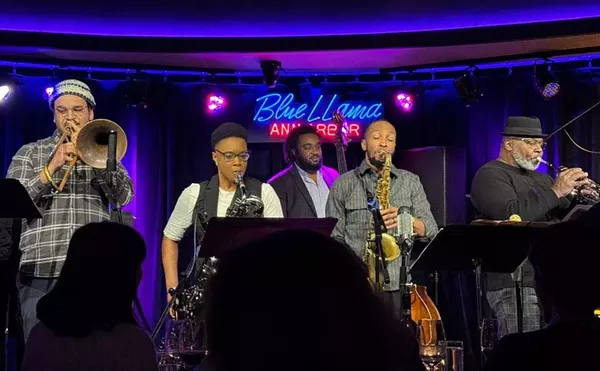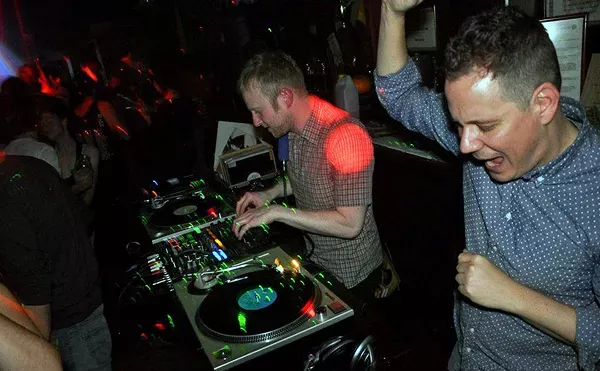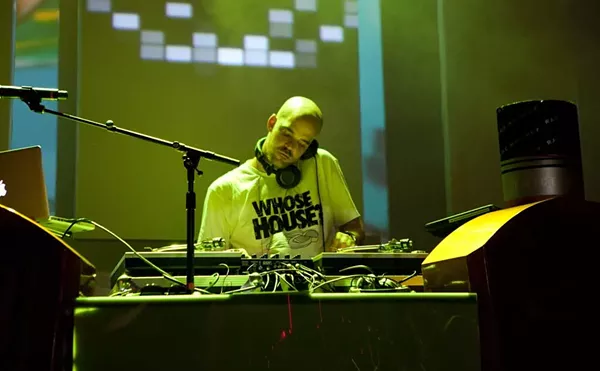If you think of jazz as a tree, you can imagine the keyboard player Craig Taborn as someone who can keep his balance on the springy outlying branches, maneuver back closer to the trunk as need be and all the while understand the deep roots holding the whole shebang upright.
The breadth of jazz, the myriad directions that the branches have grown, is part of what makes the music interesting, Taborn explains on a recent day. And he’s seen a good bit of that breadth up close.
A stalwart in the Detroit and Ann Arbor jazz scenes in the late ’80s and early ’90s, the thirtysomething Taborn played here with such artists as Marcus Belgrave and Francisco Mora before gaining prominence on the national scene as part of James Carter’s quartet. Since then he’s played with artists as diverse as Chris Potter, Susie Ibarra and Tim Berne — and he’s been garnering critical plaudits for his recent solo releases.
Talking by phone from New York City, where he lives, he describes the jazz tree as “so broad that it’s exciting. I really have a sense of history and tradition. It’s like a tree that’s flowered. … I can see the trunk and I can know where the roots are and it’s just interesting how it still grows.”
Taborn returns to old haunts this week as part of Edgefest, a three-venue, four-day, nine-concert celebration of a cutting edge tradition of jazz that stretches back to the 1960s. (And now in its eighth year, the fest itself is becoming something of a tradition.)
By happenstance, Taborn is also returning to the area during a week when the jazz tree is on display to an uncommon degree.
Little Louis
This year marks the centennials of the births of both Count Basie and Fats Waller, and following the centennials in recent years for Louis Armstrong and Duke Ellington, these events are reminders that none of the major figures in the creation of jazz is still around.
But the first generations that grew up listening to them and building on their legacy still have representatives playing artfully and spreading the musical message. For instance, there’s the 84-year-old trumpeter Joe Wilder, who makes his first Detroit appearance in years this week as part of Jim Ruffner’s ever-engaging Jazz Forum series at Grosse Pointe Unitarian Church.
Wilder’s most recent recording, Among Friends, was released last year on the Evening Star label and boasts a multi-generational A-list of guests, from saxophonist Frank Wess, (Wilder’s onetime colleague in the Basie band) to other Wilder contemporaries (like guitarist Bucky Pizzarelli) and young stars (namely pianist Bill Charlap and guitarist Russell Malone). Wilder exudes an effortless fluency throughout, whether interpreting chestnuts such as “Indiana” or underscoring the inherent jazziness of Stevie Wonder’s “You Are the Sunshine of My Life.” The biggest surprise, though, is a gospel-ballad approach that wholly recasts “Seventy-Six Trombones” and takes it a galaxy away from its beginnings on stage in The Music Man. It was just something that Wilder tried out on a gig that worked, he explains during a recent phone call.
Talking about his own place and experience in the jazz tree, Wilder chats about the great bandleaders he worked with beginning in the 1940s — frontmen as famous as Basie and Lionel Hampton, as well as less familiar names like Les Hite, Jimmie Lunceford and Sam Donahue.
And even before those band stints, Wilder earned the nickname Little Louis when, through happenstance, Louis Armstrong’s band wound up playing behind a children’s radio band that included a 5-year-old Wilder.
Asked about the changes in jazz over the years — from swing to bop and eventually to avant-garde and beyond — Wilder is nonchalant.
Some musicians and critics greeted the innovations of bebop as a bewildering shock in the late ’40s. Wilder reminisces about being around chief bop architects Dizzy Gillespie and Charlie Parker — both a few years older than Wilder — while they were still working out their new approaches and in the hire of big bands on the touring circuit. (Gillespie was actually a bandmate of Wilder’s in the Hite group.)
So when bebop came along, it seemed to Wilder to be more of an evolution than a break with the past. And the terms for styles, he says, whether bebop or avant-garde, seemed like things “the critics came up with to make themselves feel a part of the music.”
Keepers of the flames
If Wilder takes jazz back near its roots and Edgefest represents the high branches, the offerings between them are also notable this week.
At the Max M. Fisher Music Center, trumpeter Jon Faddis appears with the Professors of Jazz, an outfit led by bassist Rodney Whitaker. Many fans got their first glimpse of Faddis more than 20 years ago when Esquire magazine featured him as an up-and-coming star — and the consummate Gillespie acolyte. “He’s the best ever — including me!” Gillespie once exclaimed. And Faddis proved his dedication to the jazz tradition not only in his individual playing, but in his longtime leadership of the Carnegie Hall Jazz Orchestra, a high-water mark in the jazz repertory movement.
Meanwhile, at the Detroit Institute of Arts on Friday, T.S. Monk, the drumming son of Thelonious Monk, holds fort.
The elder Monk is widely acknowledged as the second greatest jazz composer, outranked only by the great Duke Ellington, even though the Monk songbook consists of 70-odd compositions compared to more than 1,000 penned by Ellington and his collaborators. There’s an underlying sturdiness to Monk’s tunes that seems to invite the most radical interpretations, from austere solo saxophone excursions to the lushest big bands. The last couple years have seen Monk’s classics performed by Thelonious Moog as a tongue-in-cheek synthesizer project and by Anthony Brown’s Asian American Orchestra, which embraces the traditional jazz brass and reeds plus such instruments as the Chinese mouth organ.
T.S. Monk’s band consistently celebrates Monk and (here’s the tricky part) keeps his music sounding fresh — and inspiring to improvisers — while keeping true to the hard-bopping ethos of the late ’50s and early ’60s.
In addition to Faddis and T.S. Monk, another keeper of the mainstream tradition, pianist John Hicks, sets up shop Friday and Saturday at the Harlequin Café, when he’s featured with bassist Micky Bass and his Manhattan Burn Unit. Hicks is a veteran of Art Blakey’s Jazz Messengers and one of the smokingest pianists ever to work with the late vocalist Betty Carter — or with saxophonist Pharoah Sanders. He’s been touting his own sense of the jazz tradition with recent recorded tributes to keyboard progenitors Earl Hines and Erroll Garner.
Meanwhile, the Edgefest itself celebrates a tradition within the jazz tradition. A centerpiece this year is a duet concert featuring drummer Rashied Ali — accompanist to John Coltrane’s final performances and recordings — and saxophonist Sonny Fortune. And, of course, John Coltrane is one of the signal artists in the founding of the jazz avant-garde.
Silver and Messengers
Taborn recalls first becoming aware of the tradition he’d eventually join as a kid growing up in Golden Valley, a Minneapolis suburb, son of a social worker mom and psychologist dad.
“My dad played a lot of Horace Silver. Horace Silver and his groups and the Jazz Messengers stuff were my initial relationship with jazz, along with some Miles,” he says.
He started taking piano lessons when he was 11 or 12, though he admitted he was mainly interested, at the outset, in playing the themes from Star Wars and popular television shows.
But his dad was an amateur pianist himself, and showed his son some things. And then adolescence fueled a new kind of musical curiosity, Taborn says. He was soon off finding peers to jam with; his and their interests, “pretty immediately” shifted from rock to jazz. Reid Anderson and Dave King, now bassist and drummer respectively for the crossover jazz band Bad Plus, were part of Taborn’s early musical circle, and remain so today. Beyond the jazz Taborn heard at home, Minneapolis had a thriving jazz club scene (where a mature-looking high schooler could ease through the doors) and adventurous music programs at the Walker Art Center. Taborn reels off names from Kenny Barron to his eventual employers Tim Berne and Roscoe Mitchell. “I remember seeing all of those people in high school,” he says.
The most formative period, he says, was when he moved to Ann Arbor to attend the University of Michigan in the late ’80s through early ’90s. He took some classes in the music school, but adds, “having access to Detroit as a learning place kind of superseded what I could get out of the University of Michigan. … If you could go in and play with Francisco Mora and play with Marcus Belgrave, that’s ultimately more of a certain kind of growth than you could get from taking a jazz big band class.”
The Detroit connection also led to some of his most lasting musical associations. Taborn made a connection with James Carter and was part of the saxophonist’s quartet just as it began recording and took off like few jazz acts have in recent decades. In fact, Taborn’s 1994 debut as a leader (Craig Taborn Trio on the DIW label) was a spur-of-the-moment affair to use up leftover studio time booked for a Carter session.
Taborn also hooked up with drummer Gerald Cleaver — son of a Detroit bop drummer — then also studying at the University of Michigan. Taborn plays on Cleaver’s 2001 debut disc (Adjust on Fresh Sound); Cleaver plays on Taborn’s sophomore release (Light Made Lighter on Thirsty Ear); and they’re together at Edgefest in a trio with the Copenhagen-based saxophonist Lotte Anker. Anker saw the two playing with Berne a few years back, and as Taborn puts it, “just liked what was going on, the way we were playing together.”
In fact, he says, several times other musicians have observed the Cleaver-Taborn interplay and inquired about working with them without knowing about what Taborn refers to as their “history.”
As for his own musicality, Taborn says, “My whole sort of musical life has been about trying to grow organically and sort of grow outward.” He started to explain what he was trying to do, then backtracked to come at it from the opposite direction: “I’m not trying to put specific limits on where my musical voice will take me. I’m continuing on a path. I definitely have more ideas of certain things I want to try which are sort of vague aesthetically, but they’re definitely clear in my mind.”
The growth through his three records is unmistakable. The 1994 trio record is exciting and direct, fueled by his then bandmates Tani Tabbal on drums and Jaribu Shahid on bass (formerly the backbone of Detroit’s Griot Galaxy). Light Made Lighter is another piano trio, but its music is more abstracted at times, almost jittery. The recent Junk Magic moves even further along the line of abstraction, introducing electronic keyboards and programmed sounds.
And for his next project, he’d like to use a slightly larger ensemble, “maybe a sextet with more possibilities for orchestration with the instruments and several sort of improvisational voices.”
Thinking how his work relates to the broad jazz tradition, he notes that while he’s never worked with Wilder, he worked with two other swing-era veterans, Buddy Tate and Harry “Sweets” Edison on a 1995-1996 project with James Carter. (Edison passed away in 1999, Tate in 2001.)
“It’s just a study in depth when you’re playing with those older players, the way that everything they play is sort of golden and they can utilize economy,” says Taborn.
Jazz has room for youthful giddiness, but there’s something else that comes to the fore with refinement, he continues, whether you’re speaking of Roscoe Mitchell, whose roots are in the avant-garde scene, or earlier musicians like Tate and Edison.
“There’s a connection between what they’re trying to communicate and their ability to express it. It’s really like a straight line and they’re not fumbling around anymore.”
And Taborn lands on a phrase that’s a good description for maturity in any style, whether it’s swing or the avant-garde, or any art for that matter.
What one finally hears and admires is how much artists “have grown into their voices.”
Joe Wilder appears Thursday, Oct. 14, at 8 p.m. at Grosse Pointe Unitarian Church, 17150 Maumee, Grosse Pointe; call 313-961-1714.
Jon Faddis appears Thursday, Oct. 14, at 8:30 and 10:30 p.m. in Allesee Hall at the Max, 3711 Woodward Ave., Detroit; call 313-576-5111.
The T.S. Monk Quintet appears Friday,Oct. 15, at 6:30 and 8 p.m. at the Detroit Institute of Arts, 5200 Woodward Ave.; call 313-833-7900.
Craig Taborn, Gerald Cleaver and Lotte Anker share a bill with Trio X on Saturday, Oct. 16, at 7 p.m., at Kerrytown Concert House, 415 N. Fourth Ave., Ann Arbor. For more information on Edgefest concerts (Oct. 13-16) call 734-769-2999 or see kerrytown.com.
W. Kim Heron is Metro Times managing editor. Send comments to [email protected]





